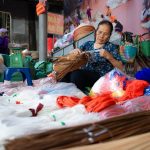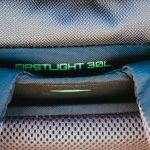Think of fabric denier as the unsung hero of your outdoor adventures. It’s the secret behind how durable and weather-resistant your gear really is. Understanding denier can help you choose materials that withstand the elements while keeping you comfortable. But how do different denier ratings influence the performance of fabrics? Let’s explore the nuances that can make or break your next expedition.
Table of Contents
Key Takeaways
- Denier measures fiber thickness, influencing fabric weight and feel; higher denier indicates thicker, heavier materials, while lower denier signifies lighter, more delicate fabrics.
- Fabrics with a denier of 600 or higher offer superior durability and strength, suitable for outdoor gear and high-wear applications.
- Higher denier fabrics provide better weather resistance, including improved water repellency and UV protection, essential for outdoor and performance gear.
- Fabrics under 200 denier are lightweight and ideal for delicate applications, while those between 200 and 600 denier balance durability with everyday use.
- Selecting the appropriate denier is crucial for matching fabric characteristics with intended uses, ensuring optimal durability and functionality in various environments.
What Is Denier and How Is It Measured?
Denier is a unit of measurement that describes the thickness of a fabric’s fibers. It’s calculated by taking the weight in grams of 9,000 meters of the fiber.
Fundamentally, a higher denier number indicates thicker fibers, while a lower number signifies thinner ones. For instance, a fabric with a denier of 100 is thicker than one with a denier of 50.
You’ll often encounter denier measurements in textiles like nylon, polyester, and other synthetic materials. This measurement affects not only the fabric’s texture but also its durability and performance.
When you’re shopping for fabrics, knowing the denier helps you choose the right material for your needs, whether it’s for clothing, upholstery, or outdoor gear.
The Relationship Between Denier and Fabric Thickness
When you look at denier, you’re not just measuring fiber thickness; it directly impacts the fabric’s overall weight and feel.
Higher denier fabrics tend to be thicker and heavier, while lower denier options are lighter and more delicate.
Understanding this relationship helps you choose the right fabric for your needs.
Denier Measurement Explained
Understanding the relationship between fabric thickness and denier can greatly impact your choice of materials.
Denier is a unit that measures the linear mass density of fibers. Fundamentally, the higher the denier number, the thicker and heavier the fabric. For instance, a 100 denier fabric is generally thinner and lighter than a 600 denier fabric.
This thickness directly affects the fabric’s strength and durability. When selecting materials, consider how denier correlates with the intended use. If you need something lightweight for breathability, opt for a lower denier. Conversely, for heavy-duty applications, a higher denier provides greater durability.
Knowing this relationship helps you make informed decisions tailored to your specific needs.
Impact on Fabric Weight
As you explore different fabrics, you’ll notice that the weight of the material often corresponds directly to its denier.
Higher denier fabrics are typically thicker and heavier, while lower denier fabrics tend to be lighter and more delicate.
This relationship is essential when you’re selecting materials for specific applications.
For instance, if you’re looking for a durable outdoor fabric, a higher denier might provide the strength and weather resistance you need.
On the other hand, if you’re after something lightweight for breathable clothing, a lower denier will be ideal.
Understanding this connection helps you make informed decisions based on the balance between weight, durability, and intended use, ensuring you choose the right fabric for your project.
Understanding Denier and Durability
While you mightn’t think about it often, the denier of a fabric plays an essential role in determining its durability.
Denier measures the thickness of individual strands of fiber in a fabric. Generally, a higher denier indicates a thicker, stronger material, which can withstand wear and tear better than lower-denier fabrics.
Denier indicates fiber thickness in fabrics; higher denier means increased strength and durability against wear and tear.
If you’re looking for something that’ll last, consider fabrics with a denier of 600 or higher, often used in outdoor gear and heavy-duty applications. Conversely, lower-denier fabrics, like those around 200, are lighter but may be less durable.
When choosing fabrics for your needs, keep denier in mind; it can make all the difference in how long your item lasts under regular use.
Denier’s Impact on Weather Resistance
When you choose fabrics, denier plays an essential role in their weather resistance.
Higher denier fabrics often offer better water repellency, UV protection, and abrasion resistance, making them more durable against the elements.
Understanding these properties can help you make informed choices for your outdoor gear and apparel.
Water Repellency Properties
Have you ever wondered how denier affects a fabric’s ability to repel water? The denier measurement can greatly influence a fabric’s water repellency. Higher denier fabrics tend to be denser, which can reduce the number of gaps through which water can penetrate. This means they often provide better protection against the elements.
Here’s a quick comparison of denier ratings and their water repellency:
| Denier Rating | Water Repellency Level |
|---|---|
| 30 | Low |
| 70 | Moderate |
| 150 | High |
| 300 | Very High |
| 500+ | Excellent |
Choosing the right denier fabric can enhance your comfort and performance in wet conditions. Keep this in mind as you shop for your next outdoor gear!
UV Protection Factors
Denier plays an essential role in a fabric’s UV protection capabilities.
When you choose fabrics with higher denier counts, you’re likely opting for materials that offer better resistance to harmful UV rays. Higher denier fabrics are typically thicker and denser, which means they can block more sunlight from penetrating through. This is vital if you’re looking for outdoor gear or clothing that protects your skin from sun damage.
Additionally, the weave and finish of the fabric contribute to its overall UV protection, but denier remains a key factor.
Abrasion Resistance Levels
While selecting fabrics for outdoor gear, understanding abrasion resistance levels is essential, especially since higher denier counts often lead to enhanced durability.
Fabrics with a higher denier rating can withstand more friction and wear, making them ideal for items like backpacks, tents, and outdoor apparel. When you’re out hiking or camping, you want gear that can handle rough terrains without easily tearing or fraying.
Additionally, consider the type of activities you’ll engage in. If you’re planning on rugged excursions, investing in higher denier materials will pay off.
Common Denier Ranges in Fabrics
When you explore fabric options, you’ll notice that different denier ranges greatly impact the material’s texture, durability, and intended use. Generally, lower denier fabrics, such as those under 200, are lightweight and ideal for delicate applications like linings and sheer garments. Mid-range denier fabrics, between 200 to 600, offer a balance of durability and weight, perfect for everyday clothing and some outdoor gear. Higher denier fabrics, over 600, are robust and designed for heavy-duty use in products like tents and backpacks.
| Denier Range | Characteristics |
|---|---|
| Under 200 | Lightweight, delicate fabrics |
| 200 – 600 | Balanced, versatile materials |
| Over 600 | Heavy-duty, durable options |
Applications of High-Denier Fabrics
High-denier fabrics are essential in a variety of practical applications due to their impressive strength and durability. You’ll find these fabrics in items like heavy-duty workwear, where resistance to wear and tear is vital.
Outdoor enthusiasts often rely on high-denier materials for backpacks and gear that need to withstand rough conditions. Additionally, industries such as automotive and aerospace utilize these fabrics for interior upholstery and insulation, ensuring long-lasting performance.
Even in home furnishings, high-denier textiles provide stylish yet resilient options for upholstery and drapery. By choosing high-denier fabrics, you’re investing in products that not only look good but also stand up to the rigors of daily life, making them a smart choice for various uses.
The Role of Denier in Outdoor Gear
Denier plays an essential role in the performance of outdoor gear, directly impacting its durability and functionality. When you choose gear like tents, backpacks, or sleeping bags, the denier rating indicates how strong and resilient the fabric is.
Higher denier fabrics tend to withstand abrasions, tears, and harsh weather conditions better than lower denier options. For instance, a tent made from 150D nylon is more robust than one made from 30D nylon, making it more suitable for rugged environments.
Additionally, the denier affects weight; while higher denier fabrics provide strength, they may also add weight. Therefore, finding the right balance between denier and weight is vital for ensuring your outdoor gear meets your adventurous needs.
Denier in Clothing Fabrics
Choosing the right fabric isn’t just important for outdoor gear; it’s equally significant in clothing. When you consider denier, you’re looking at the thickness of the fibers. A lower denier means lighter, more breathable fabrics, which are great for summer wear.
On the other hand, higher denier fabrics are often more durable, making them ideal for everyday clothing that needs to withstand wear and tear.
Higher denier fabrics offer increased durability, perfect for everyday wear that endures daily challenges.
You’ll find that denier impacts not just weight but also the overall feel of the garment. For instance, denser fabrics can provide a smoother texture, while lighter options might feel softer against your skin.
Understanding denier helps you select clothing that balances comfort, style, and longevity, ensuring you get the best value for your wardrobe.
Selecting Fabrics Based on Denier Count
When you’re selecting fabrics, understanding the denier count can make a significant difference in your choices.
Higher denier counts typically mean greater durability, making them suitable for items like backpacks and outdoor gear. If you’re after lightweight and breathable options, look for fabrics with lower denier counts, like those used in activewear.
Consider the intended use of the fabric: if you need something resistant to wear and tear, opt for a higher denier. Conversely, if comfort and flexibility are your priorities, lower denier fabrics might be the way to go.
Always balance durability with your specific needs to guarantee you choose the right fabric for your project or lifestyle.
Frequently Asked Questions
How Does Denier Affect Fabric Breathability?
Denier affects fabric breathability by influencing the thickness and density of the fibers. Higher denier fabrics tend to be less breathable, while lower denier options often allow for better airflow, keeping you cooler and more comfortable.
Can Low-Denier Fabrics Be Durable for Everyday Use?
While you might think low-denier fabrics are delicate, they can still pack a punch in durability for everyday use. With proper care, they’ll surprise you by standing the test of time and wear.
What Are the Disadvantages of High-Denier Fabrics?
High-denier fabrics can be heavier and less breathable, which might make them uncomfortable in warm weather. They also often come with a higher price tag, potentially straining your budget for certain projects or clothing needs.
How Does Denier Influence Fabric Cost?
Denier directly impacts fabric cost since higher-denier materials often require more resources to produce. You’ll notice that thicker, more durable fabrics tend to be pricier, reflecting their quality and longevity compared to lighter options.
Does Denier Impact Fabric Color Vibrancy?
You might think denier’s the secret ingredient for vibrant fabric colors, but it’s not the whole story. While it can affect dye absorption, factors like dye type and fabric structure play bigger roles in color brilliance.
- The Meaning and Properties of Tetron Fabric - June 17, 2025
- Understanding Tetron Fabric: Definition and Characteristics - June 17, 2025
- What Is Tetron Fabric? A Complete Guide - June 17, 2025





